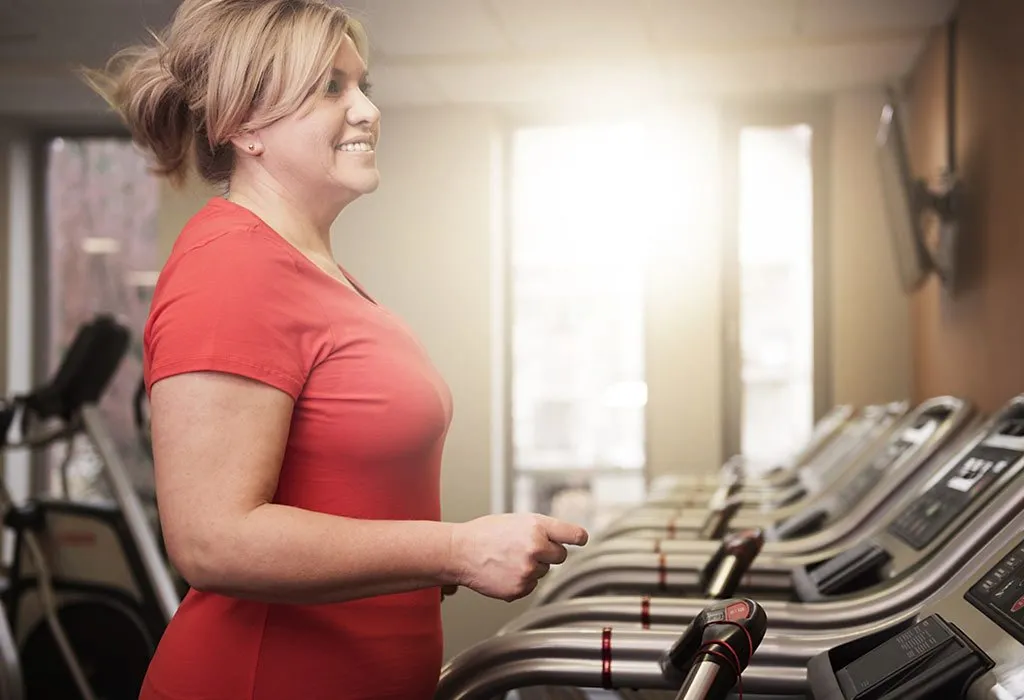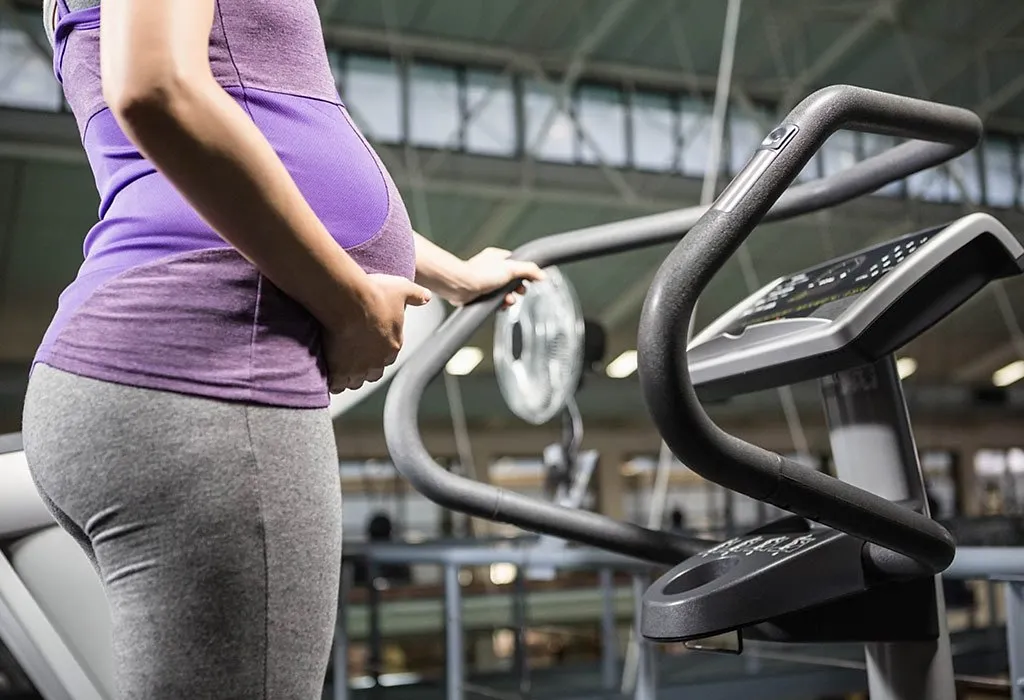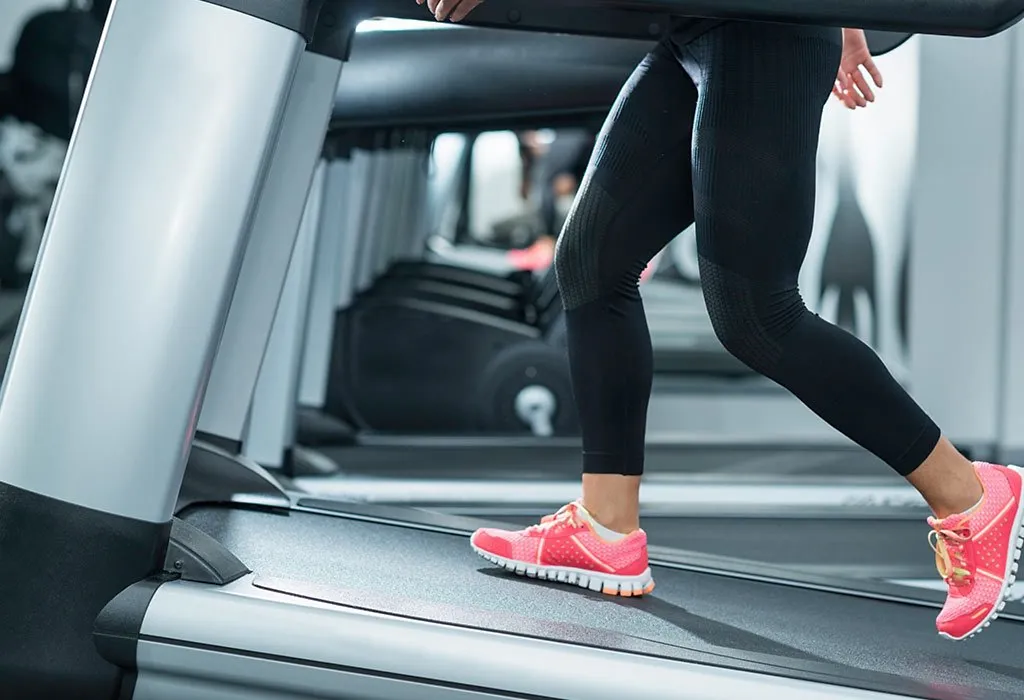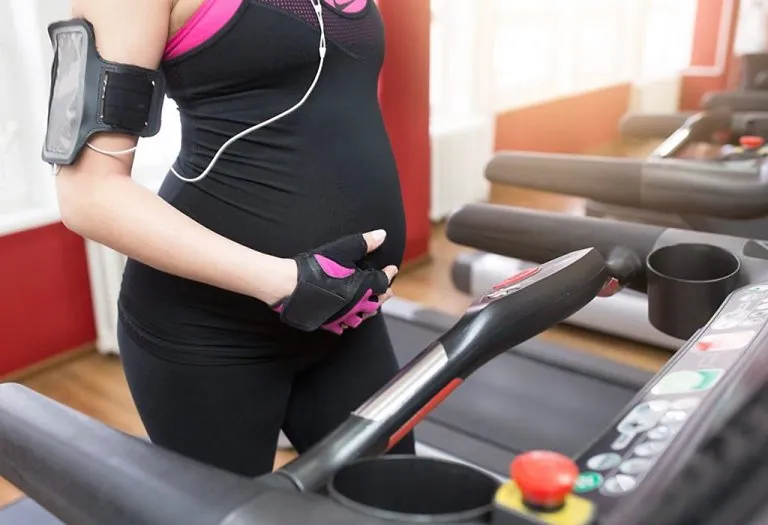Workout on Treadmill during Pregnancy: Is It Safe?

- Can Pregnant Women Use a Treadmill?
- Benefits of Using a Treadmill Safely During Pregnancy
- How to Perform Treadmill Workout in Pregnancy
- Recommended Treadmill Workout for Each Trimester
- Tips to Consider While Using Treadmill When Pregnant
- When to Stop Running on a Treadmill During Pregnancy
- FAQs
Exercise is of great importance at all times, and even during pregnancy. The body is undergoing numerous changes, and your weight is also climbing steadily as a result of these changes. Keeping your body in prim and proper condition requires exercising, but there are only a few exercises that are safe for you. Using a treadmill during pregnancy is a much safer alternative than going outside, and it can be achieved in a few simple steps as well. The treadmill provides a controlled environment that minimizes the risk of falls and allows you to adjust the intensity according to your comfort level. Read on to learn about walking on the treadmill in pregnancy.
Can Pregnant Women Use a Treadmill?
It is true that women are asked to follow a major list of restrictions, especially when it comes to exertion, exercises and movements of the body. While running or sprinting outside or on the treadmill is a no-go, you can definitely indulge in some normal or speed walking on the treadmill to keep yourself healthy.

Benefits of Using a Treadmill Safely During Pregnancy
Maintaining an active lifestyle during pregnancy is essential for both your health and your baby’s well-being. Using a treadmill safely can offer numerous benefits while allowing you to exercise in a controlled environment. Here are some key advantages of using a treadmill during pregnancy:
- Treadmills provide a stable and controlled environment, reducing the risk of tripping or falling compared to outdoor walking surfaces.
- You can easily adjust the speed and incline of the treadmill to match your comfort level and fitness goals, ensuring a safe and effective workout.
- Walking on a treadmill offers a low-impact exercise option, which helps minimize stress on your joints and ligaments, especially important as your body undergoes changes during pregnancy.
- Regular treadmill exercise can enhance cardiovascular health, improve circulation, and increase overall stamina, which is beneficial for both you and your baby.
- Using a treadmill helps manage weight gain, which can contribute to a healthier pregnancy and potentially ease the delivery process.
- Physical activity, including walking on a treadmill, can help alleviate stress, reduce symptoms of depression, and improve overall mood, contributing to a more positive pregnancy experience.
How to Perform Treadmill Workout in Pregnancy
Before beginning with any kind of workout, it is important to talk to your doctor or gynaecologist and get their go-ahead for the same. If any risks of pregnancy complications exist, it is best to stay away from it. If you get a go-ahead from your gynaecologist, here is how you can perform treadmill workout in pregnancy.
- Begin with a small warmup for a few minutes to bring up your heart rate gradually.
- Then, increase the speed a bit and walk until you start to breathe with some effort.
- Lower the speed again and walk calmly for a couple of minutes.
- Follow up by increasing the incline and continue walking for another 5 minutes.
- Bring down the speed and walk calmly, before increasing the inclination further and continuing with it.
- Now start reducing the incline every 30 seconds and reduce the pace gradually, before ending the walk.
- Undergo a stretching session to cool down and return to normalcy.
Recommended Treadmill Workout for Each Trimester
Treadmill workouts can be an excellent way to maintain fitness levels throughout the trimesters, but it’s important to adjust the workout according to the stage of pregnancy. Below is a recommended treadmill workout plan for each trimester, focusing on time, intensity, speed, and incline.
| Trimester | Time/Duration | Intensity | Speed | Incline |
|
First |
20-30 minutes | Low to Moderate | 2.5-3.5 mph | 1-2% |
| Second | 25-35 minutes | Moderate | 3.0-4.0 mph | 2-3% |
| Third | 20-30 minutes | Low | 2.5-3.0 mph | 0-1% |
Tips to Consider While Using Treadmill When Pregnant
Using the treadmill when you are pregnant won’t be as easy as before. Staying within the limits of safety is highly important. There are a bunch of tips you can utilize to keep a track of your well-being as well as ensure that you stay in optimum health throughout the exercise.
1. Hug Your Tummy When You Walk
Your abs are going to take the biggest brunt of strain during pregnancy and even during exercise. Hold your hands close to your stomach and try and hug the tummy, as if you were holding the baby close to you. When doing so, you will inherently feel the internal muscles contract. This muscle exercise helps in strengthening your core, which is quite essential to give you the strength necessary during delivery as well as cut down on the stress experienced by your back.
2. Stretch Gently Before and After the Walk
Stretching is a necessary precursor for any exercise regimen. It makes sure that your muscles and tendons are ready to undergo an exercise and can also be relaxed once it is done. However, during pregnancy, you should take care to not stretch beyond what’s comfortable for you. The changed physical structure of your body leaves many muscles and joints looser than before, which may not respond ideally to the stretching.

3. Stay Hydrated Throughout Your Treadmill Regimen
Any kind of exercise, even walking for extended periods, results in burning of fat reserves in your body, which raises the core temperature within you. Maintaining optimal body temperature is vital to keep your baby safe and sound. Sweating will also drain your water levels, so keep drinking water regularly.
4. Establish a Level of Exertion That is Specific to You
Whether you’ve been exercising before pregnancy or have decided to keep yourself healthy during this phase, you would have a good idea of how much pressure you might be under, at a particular point during your workout. Try to establish a scale of sorts, ranging from 1 to 10, where 10 is the most intense for you. During pregnancy, it is best to remain somewhere between 5 to 6.5 at the most.

5. Use the Railings on the Treadmill as Liberally as You Want to
When walking on the treadmill, especially if you are using an incline, there is a chance you might lose your balance since the weight is shifted to one end. You might be young but you are also carrying a baby within you. So use the railings to keep yourself steady when you walk.
6. Make Use of Your Previous Workout Statistics as a Reference Point
If you’ve already been engaging in basic workout regimens prior to getting pregnant, then it should be simple to set a new pregnancy workout regimen. The major focus during pregnancy is to maintain a good level of fitness and health, without aiming for any specific goals. Therefore, you can cut down on the actual time you spend on the treadmill and instead increase the duration of warming up as well as cooling down.

7. Support Your Baby Bump
Your tummy will increase rapidly in size and will begin to make its weight felt as your pregnancy progresses. Certain specific movements can lead to pain since your bump will put extra pressure on your back for support. Therefore, make use of a band or a strap that supports your tummy and allows you to use the treadmill easily.
8. Opt for Progressively Angular Walks Instead of Faster Ones
Using the treadmill when you are pregnant will feel quite different if you are already used to an intense regimen prior to your pregnancy. While you may want to stay within the safety limits, it might feel good to push yourself a little at times. Try to adjust the inclination of the treadmill instead of the speed to aid this. This helps in strengthening your legs without affecting your heartbeat.

9. Converse With Yourself as a Way to Gauge Your Intensity
It may not always be possible to monitor your heart rate or other factors when using the treadmill, as well as knowing if you are overexerting yourself. The easiest way to do so is to try and talk alone as if you are conversing with someone else. If you cannot hold a conversation easily, it means you are pushing yourself too hard and should cut down immediately.
10. Adjust With Progress in Pregnancy
As your pregnancy progresses, make sure your treadmill regimen slows down to stay in pace with it. Your baby’s safety is more important than being fit and you will be able to return to your regimen after the delivery.

When to Stop Running on a Treadmill During Pregnancy
Despite being fit and healthy, exercising during pregnancy could, in fact, be harmful in cases and affect your pregnancy as well. Treadmill during pregnancy first, second and third trimester is safe to use, but with precautions. Noticing any of the signs mentioned below should immediately be brought to your doctor’s notice, preceded by ending your workout then and there.
- Observing that the baby’s kicks and movements have reduced in frequency
- Experiencing pain resembling contractions at regular intervals
- Pain in the chest that can get extreme
- An extreme headache, often accompanied by dizziness or even spells of fainting
- Leakage from the vagina either in the form of blood or any other discharge
FAQs
1. Can treadmill workouts help manage pregnancy-related back pain?
Yes, regular treadmill workouts can help strengthen your back and core muscles, which may alleviate some pregnancy-related back pain. However, it’s important to listen to your body and consult your healthcare provider for personalized advice.
2. Can treadmill exercise cause round ligament pain during pregnancy?
It’s possible for treadmill exercise to exacerbate round ligament pain if the intensity or speed is too high. To minimize discomfort, ensure you maintain a moderate pace and avoid sudden movements or jerky motions. If pain persists, consider adjusting your routine or consulting your healthcare provider.
3. How can I safely incorporate intervals into my treadmill workout while pregnant?
Interval training can be safe if done correctly. Focus on low-impact intervals, such as alternating between a brisk walk and a moderate pace, rather than high-intensity bursts. Ensure you listen to your body and avoid overexertion. Consult your healthcare provider to tailor intervals to your fitness level and pregnancy stage.
4. What should I do if I experience pelvic pressure during treadmill exercise?
Pelvic pressure can occur as the uterus expands. If you experience this, consider reducing the incline and speed of your treadmill workout. Opt for a more level surface and avoid exercises that cause excessive strain. If the pressure is persistent or painful, consult your healthcare provider for personalized guidance.
This was all about pregnancy and treadmill. It is good to know that walking on the treadmill while pregnant has its advantages when you follow the right steps and keep yourself safe and hydrated. A healthy body is highly necessary during pregnancy since it directly impacts the health of the baby.
References/Resources:
1. Safe pregnancy exercises for each trimester: prenatal workouts; National Academy of Sports Medicine; https://blog.nasm.org/pregnancy-exercises-by-trimester
2. Exercise During Pregnancy; American Pregnancy Association; https://americanpregnancy.org/healthy-pregnancy/is-it-safe/exercise-during-pregnancy/
3. Third Trimester; University of Rochester Medical Center; https://www.urmc.rochester.edu/ob-gyn/obstetrics/pregnancy/third-trimester.aspx
4. FAQs: Exercise During Pregnancy; American College of Obstetricians and Gynecologists; https://www.acog.org/womens-health/faqs/exercise-during-pregnancy
5. Cooper. D. B, Yang. L; Pregnancy and Exercise; National Library of Medicine; https://www.ncbi.nlm.nih.gov/books/NBK430821/
6. Exercise in pregnancy; NHS; https://www.nhs.uk/pregnancy/keeping-well/exercise/
7. Anevska. K, Mahizir. D, Briffa. J, Jefferies. A, et al. Treadmill Exercise before and during Pregnancy Improves Bone Deficits in Pregnant Growth Restricted Rats without the Exacerbated Effects of High Fat Diet (Nutrients); National Library of Medicine; https://www.ncbi.nlm.nih.gov/pmc/articles/PMC6627539/; May 2019
Also Read:
Squats in Pregnancy
Zumba during Pregnancy
Jumping while Pregnant
Weight Lifting when Being Pregnant
Was This Article Helpful?
Parenting is a huge responsibility, for you as a caregiver, but also for us as a parenting content platform. We understand that and take our responsibility of creating credible content seriously. FirstCry Parenting articles are written and published only after extensive research using factually sound references to deliver quality content that is accurate, validated by experts, and completely reliable. To understand how we go about creating content that is credible, read our editorial policy here.
























